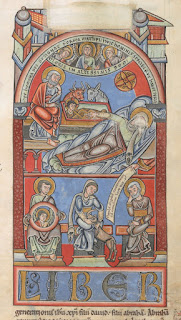
|
The Ascension of Christ
13th-c. apse window, Lyons Cathedral
(Image: Wikipedia)
|
A Sermon for the Ascension of the Lord
From the Speculum Ecclesiae of Honorius Augustodunensis (early 12th cen.)[1]
The sun was lifted up, and the moon stood fixed in its order (Hbk 3.11).[2] Christ is the eternal sun, by which all the angels’ choirs are enlightened; he is the true light, by which all souls are enlightened (Jn 1.9). While hidden here beneath the cloud of the flesh, he is surrounded by the gloom of our fragility—but at last he surfaced from the darkness of hell and today is lifted gloriously up above the stars and exalted above all the angels’ dignities, the Lord of Majesty at the right hand of the Father. The moon or Church, enlightened by him, stood fixed in her order,[3] as with the apostles she watched him ascend the heavens. The apostles indeed formed the Church’s order as they established for her the order of living rightly and instructed her in how to direct her course according to the Sun of righteousness (Mal 4.6). O how splendid these horns the newborn moon has extended today, as the sun rising high poured into it the brilliance of eternal splendor! O how clear her visage, as she stood fixed in her order, watching with the apostolic choir—who formed her order—and with the Virgin Mother of God—who served as her type—as her flesh penetrated the outer heavens with her head, that is, with her Redeemer, with her Bridegroom, with her God! O what happiness mounts up today in heaven for the angels, as the Son of God, who was directed from the palace to the prison on behalf of a servant—indeed from his homeland into exile, an exile on behalf of an exile—as he returns today triumphantly to the Father’s kingdom! So too this is called the day of God’s triumph, when the singular Conqueror of death is glorified as the Author of life with hymns of praise by the Senate of the heavenly Court.




























